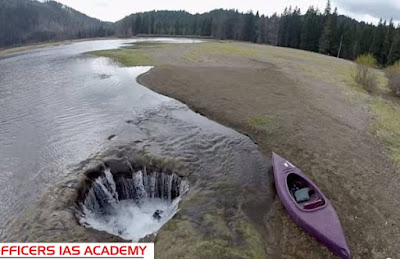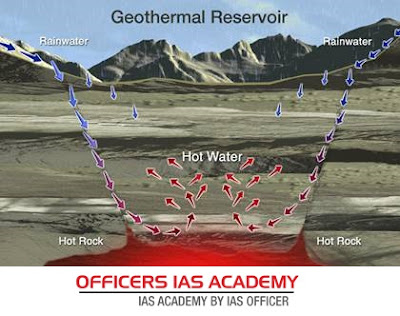·
Topographical features
formed by underground water can be seen particularly, in an highland composed
of limestone on a large scale.
·
This distinctive topography
formed due to the action of underground
·
‘Karst’ word comes from the
Karst region of Adriatic Sea coast in Croatia (Yugosalvia) where such
formations are noticeable.
·
This region is made up of
limestone rocks, where underground water is the most active agent of gradation.
·
The topographical features created by
the work of underground water on limestone are of two types.
(a) Topographical features formed on
the surface, like sink holes and swallow holes.
(b) Topographical features formed underground like caverns, stalactites and stalgmites.
a) Topographical features formed on the surface
:
1. Sink Holes :
·
A sinkhole is a surface
depression in a region of limestone or chalk terrain.
·
Some sinkholes are filled with soil
washed from nearby hillsides, while others are steepsided, dugholes.
·
They develop where the limestone is
more susceptible to solution, weathering or where an underground cover near the
surface has collapsed.
2. Swallow Holes :
·
They are cylindrical in
shape lying underneath the sinkholes at some depth.
·
In limestone regions, the surface
streams often enter the sinkholes and then disappear underground through
swallow holes.
b) Topographical features formed underground :
3. Caverns :
·
Caverns are
interconnected subterranean cavities in bedrock formed by the corrosions action
of circulating underground water on limestone.
·
They are found near Dehradun in Uttarakhand and in Almora in Kumaon Himalayas.
·
The caves of Kotamsar in the tribal
district of Bastar in Chhattisgarh are famous caverns of India.
4. Stalactites :
·
They are the major depositional
features formed in the caverns in limestone regions.
·
The water containing limestone in
solution, seeps through the roofs of the caverns in the form of a continuous
chain of drops.
·
A portion of the water dropping from the
ceiling gets evaporated and a small deposit of limestone is left behind on the
roof.
·
This process continues
and deposit of limestone grows downwards like pillars.
5.
Stalagmites :
·
When the remain in portion of the water
dropping from the roof of the cavern falls on the floor, a part of it is again
evaporated and a small deposit of limestone is left behind.
·
This deposit grows upward
from the floor of the cavern.
·
These type of depositional features are
called stalagmites.
·
As the process grows, both stalactite and
stalagmite often join together to form vertical columns in the caverns.
C.SPRINGS :
·
Springs are surface outflow of ground water through an opening in
a rock under hydraulic pressure.
·
In such cases the aquifer is either exposed at the surface or it
underlies an impermeable rocks.
·
The amount of water in the aquifer depends upon the amount of
rainfall in that area, landform characteristic and the size of the aquifer.
Hot Spring :
·
Sometimes the water that flows out of the spring is hot.
·
Such
springs are called hot springs.
·
They generally occurs in areas of active or recent vulcanism.
·
In volcanic regions the underground water gets heated up by
coming in contact with hot rocks or steam.
·
Hot
springs are found in many parts of India, especially in the Himalaya in Jammu and Kashmir and Himachal Pradesh.
·
They
also occur in Uttarakhand, Jharkhand, Haryana and Assam. Manikaran in Kulu
Valley, Tatapani near Shimla, Jwalamukhi in Kangra, Sohna in Haryana, Rajgir
and Sitakund in Jharkhand and Badrinath in Uttarakhand have hot springs.
D.GEYSERS :
· Springs emitting hot water and steam in forms of fountains or
jets at regular intervals are called geysers.
· In case of a geyser, hot water is ejected violently because of the
pressure created by steam.
· The water does not come out continuously but it flows out intermittently.
· The
period between two emissions is sometimes regular.

























Thnx a lot.. Sir
ReplyDeleteVery useful for aspirants candidates for competitive exams
DeleteThanks ji
ReplyDeleteThanks for sharing this awesome blogs..
ReplyDeleteUnderground Water Condenser
Industrial Pipe Insulation
This comment has been removed by the author.
ReplyDeleteReally wonderful and nice blog.
ReplyDeleteThanks for sharing. Keep it up.
UPSC Book Shop
UPSC Books
Help us make more transplants possible!
ReplyDeleteWe are urgently in need of kidney donors in LS foundation center to help patients who face life time dialysis problem unless they under go Kidney Transplant. Here we offer financial rewards to interested donors. For more details contact us via Email: kidneylivertc@gmail.com
URGENT LOAN IS AVAILABLE NOW
ReplyDeleteTODAY I GOT MY DESIRED LOAN AMOUNT $760K FROM A RELIABLE,TRUSTED AND REGISTERED PRIVATE LOAN COMPANY LAST WEEK,BUSINESS/HOME/COMPANY/PROJECT/PERSONAL LOAN? ARE NOW AFFORDABLE HERE FOR YOU TODAY CONTACT Email profdorothyinvestments@gmail.com
Hello, I'm here to testify of how i got my real estate business loan from PROF. MRS.DOROTHY JEAN INVESTMENTS (profdorothyinvestments@gmail.com) I don't know if you are in need of an urgent loan to pay bills, start business or build a house, they offer all kinds of loan Ranging from $5,000.00USD to $2,000,000.00USD with a low interest rate of 2% and loan duration of 1 to 33 years to pay back the loan secure and unsecured. Are you losing sleep at nights worrying how to get a Legit Loan Lender?
MRS.DOROTHY JEAN holds all of the information about how to obtain money quickly and painlessly without cost/stress via Contacts Email profdorothyinvestments@gmail.com
This comment has been removed by the author.
ReplyDeleteOH LAWDY
ReplyDeleteDEM ROCKS IS INTRESTIN', BOUT AS MUCH AS GRANNY'S APPLE PIE!
ReplyDeleteMuğla
ReplyDeleteBitlis
Karaman
8HF6VY
Isparta
ReplyDeleteTunceli
Yozgat
Çorum
Konya
TZY7M
Ağrı
ReplyDeleteDiyarbakır
Bolu
Elazığ
Siirt
V5DCC
Bayburt
ReplyDeleteKars
Batman
Urfa
İzmir
H272A
Bursa
ReplyDeleteKırşehir
Muş
Mersin
Çanakkale
4İQRKY
Samsun
ReplyDeleteNevşehir
Van
Bartın
Edirne
QUİA
Afyon
ReplyDeleteBalıkesir
Kırklareli
Amasya
Bilecik
E1S06
Aksaray
ReplyDeleteAydın
Kütahya
Rize
Bingöl
XAOM5
Afyon
ReplyDeleteAntalya
Erzurum
Mersin
izmir
N0PH
Malatya
ReplyDeleteKırıkkale
Aksaray
Bitlis
Manisa
FBSYL
Kırşehir Lojistik
ReplyDeleteHakkari Lojistik
Kars Lojistik
Konya Lojistik
Kilis Lojistik
YOH
istanbul evden eve nakliyat
ReplyDeletebalıkesir evden eve nakliyat
şırnak evden eve nakliyat
kocaeli evden eve nakliyat
bayburt evden eve nakliyat
6DA7S
ED55D
ReplyDeleteİstanbul Lojistik
Mamak Boya Ustası
Erzincan Şehir İçi Nakliyat
İzmir Lojistik
Kırşehir Parça Eşya Taşıma
Kars Parça Eşya Taşıma
Isparta Şehir İçi Nakliyat
Muş Şehir İçi Nakliyat
Bayburt Lojistik
9CFF7
ReplyDeletePursaklar Boya Ustası
Ankara Evden Eve Nakliyat
Isparta Lojistik
Van Parça Eşya Taşıma
Kripto Para Borsaları
Altındağ Parke Ustası
Bartın Şehirler Arası Nakliyat
Altındağ Boya Ustası
Iğdır Lojistik
48F31
ReplyDeleteIsparta Şehirler Arası Nakliyat
Eryaman Parke Ustası
Tunceli Şehirler Arası Nakliyat
Samsun Lojistik
Elazığ Evden Eve Nakliyat
Siirt Şehirler Arası Nakliyat
Isparta Şehir İçi Nakliyat
Gölbaşı Boya Ustası
Kastamonu Evden Eve Nakliyat
2BAF0
ReplyDeleteManisa Şehir İçi Nakliyat
Silivri Çatı Ustası
Bingöl Şehir İçi Nakliyat
Tunceli Şehirler Arası Nakliyat
Balıkesir Evden Eve Nakliyat
Burdur Şehir İçi Nakliyat
Siirt Lojistik
Mamak Parke Ustası
Afyon Şehir İçi Nakliyat
A2803
ReplyDeletebinance %20 indirim
97B1C
ReplyDeletebilecik telefonda görüntülü sohbet
kütahya rastgele sohbet
zonguldak telefonda sohbet
antep rastgele görüntülü sohbet uygulamaları
aydın mobil sohbet odaları
gümüşhane sesli mobil sohbet
maraş en iyi rastgele görüntülü sohbet
muğla canlı sohbet ücretsiz
manisa en iyi görüntülü sohbet uygulaması
7D268
ReplyDeletezonguldak rastgele görüntülü sohbet
nevşehir canli sohbet bedava
çanakkale sohbet
bartın bedava sohbet uygulamaları
mardin sesli görüntülü sohbet
malatya mobil sohbet odaları
kastamonu rastgele sohbet siteleri
çanakkale sesli sohbet sesli chat
parasız sohbet siteleri
A0D01
ReplyDeleteCoin Madenciliği Nedir
Mexc Borsası Kimin
Dlive Takipçi Satın Al
Binance Borsası Güvenilir mi
Kripto Para Kazma
Binance Sahibi Kim
Kwai Beğeni Hilesi
Nonolive Takipçi Hilesi
Kaspa Coin Hangi Borsada